Your Time has Finished
Loading...
BMAT 2005-S1
Your Score: %
Average Score of All Users:
You performed better than of students
Section Breakdown
| Your Score | Average of all Users | Percentile | |
|---|---|---|---|
| BMAT 2005 S1 |
BMAT 2005 S1
Your score:
Average score:
You performed better than of students
This section is Section 1 of 3.
Speed as well as accuracy is important in this section. Work quickly, or you might not finish the paper. There are no penalties for incorrect responses, only marks for correct answers, so you should attempt all 35 questions. Each question is worth one mark.
You must complete the answers within the time limit. Calculators are NOT permitted.
Good Luck!
Note – if press “End Exam” you can access full worked solutions for all past paper questions
The diagram below shows the tiling pattern for a club floor covering a large area. The pattern consists of three tiles: a large + shaped (shown black), a medium square (shown white) and a small square (shown grey).

Explanation
The correct answer is C.
Counting the number of each tile in the diagram, there are 9 large, 9 medium and 20 small tiles. The ratio would be 9:9:20~10:10:20=1:1:2.
“The traditional school sports day – featuring races with clear winners and losers – is being replaced in some schools by “fun days” of non-competitive games. The rationale for this is that the self esteem of children who always lose in competitive races is damaged. But in adult life, competition for jobs, partners and social status is unavoidable. Schools should recognise this and revert to traditional sports days.”
Explanation
The correct answer is D.
The conclusion here is that schools should recognise this and revert to traditional sports days and the reason given is that adult life involves competition. However, we have to ask why is that relevant? We are assuming that the role of school sports is to prepare children for adult life.
To pass the time on a long car journey, two children were playing a counting game. Julia counted the number of animals they saw, and Tim counted their legs.
After 15 minutes, all they had seen was birds and sheep. Julia had counted 13 animals and Tim had counted 36 legs.
Explanation
The correct answer is B.
Knowing that each bird has 2 legs and each sheep has 4 legs,we can form a pair of simultaneous equations:
b+s=13 and 2b+4s=36, where b and s are the number of birds and sheep counted respectively. Solving:
(b+s=13)x2=(2b+2s=26)
(2b+4s=36)-(2b+2s=26)
2s=10
s=5.
So they had seen 5 sheep
If all the matter in the universe was created in the Big Bang, and if the universe has been expanding ever since, galaxies would tend to move apart, not towards each other.
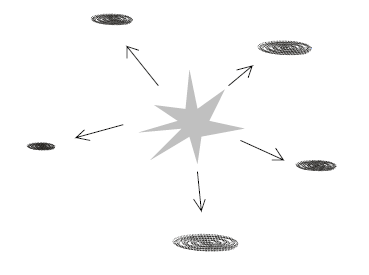
However, galaxies can and do collide.
Explanation
The correct answer is A.
The statement states that galaxies tend to move apart from each other but can however, they collide. This all occurs within the parameters of the universe, which is expanding. Therefore, in order for both statements to be compatible with each other, i.e. have galaxies that normally move apart from each other but may collide, local movement is independent of overall expansion. This is summarised in statement A.
Statements B-E are incorrect because there is no mention of such information in the text. They also do not explain how these two parameters can occur simultaneously.
The table below shows cancer deaths per million population as a function of age for England and Wales in the period 1971 to 1995.
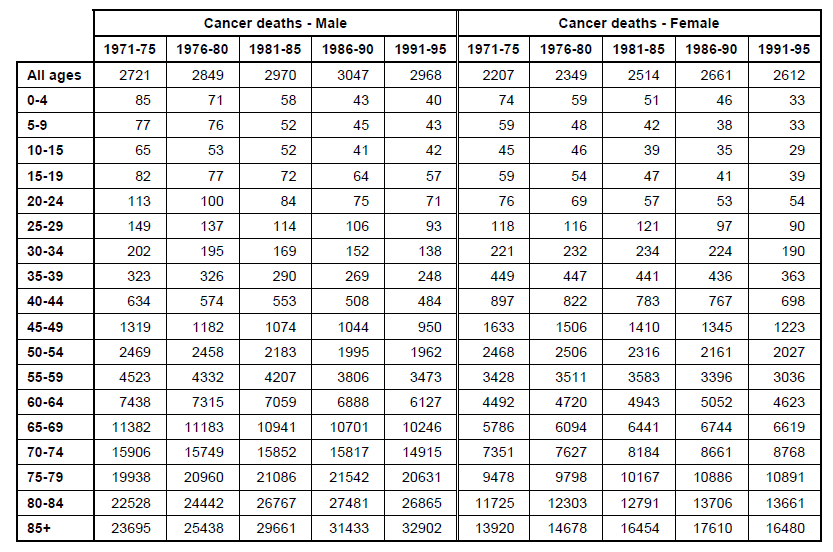
Between 1991 and 1995 the cancer death rate between ages 30 and 54 for females exceeded that for males.
Explanation
The correct answer is B.
For all of the age categories 30-34, 35-39, 40-44 and 45-49, the female cancer death rate exceeds the male cancer death rate for all the periods shown.
“We worry that the pesticides used on crops may get into our food, but few people know that plants make natural pesticides to protect them against threats to their existence. Every day we eat fruit and vegetables containing these natural pesticides. Since our consumption of natural pesticides vastly outweighs that of synthetic pesticides, our health is at greater risk from natural pesticides than from synthetic ones.”
Explanation
The correct answer is B.
The passage concludes that ‘since our consumption of natural pesticides vastly outweighs that of synthetic pesticides, our health is at greater risk from natural pesticides than from synthetic ones.’ Therefore, statement B is correct because if humans can tolerate pesticides in food crops then our health is not at risk from natural pesticides.
Statements A, C & D do not weaken the argument if true. In fact, if statement C would be correct, this would strengthen the above argument.
Stamp duty is a tax paid when buying a house, and varies depending on the price. Tax at the appropriate rate is paid on the total price of the house.
The current structure of the tax is as follows:
|
Price of house |
Tax paid (as a percentage |
|
on the total price) |
|
|
£0 to £119 999 |
0% |
| £120 000 to £249 999 |
1% |
|
£250,000 to £499 999 |
3% |
| Over £500 000 |
4% |
So, for example, if a house is bought at £200 000, the buyer has to pay 1% of the total price or £2 000 in stamp duty.
Where appropriate answers should be rounded to the nearest £100.
Explanation
The correct answer is B.
350000×0.03=£10500
Stamp duty is a tax paid when buying a house, and varies depending on the price. Tax at the appropriate rate is paid on the total price of the house.
The current structure of the tax is as follows:
|
Price of house |
Tax paid (as a percentage |
|
on the total price) |
|
|
£0 to £119 999 |
0% |
| £120 000 to £249 999 |
1% |
|
£250,000 to £499 999 |
3% |
| Over £500 000 |
4% |
So, for example, if a house is bought at £200 000, the buyer has to pay 1% of the total price or £2 000 in stamp duty.
Where appropriate answers should be rounded to the nearest £100.
Explanation
The correct answer is C.
D can be eliminated because it suggests that all the houses within a single price bracket with incur the same amount of tax (e.g. the tax payable on a £120 000 house is the same as on a £249 999 house), which is not true.
B can also be eliminated because the changes in the amount of tax paid when moving from one tax band to the next is not large enough.
A and C have a similar shape, but A suggests that for a £400000 house, the tax paid would be less than £10000, whereas C suggests that for a house of the same price the tax paid would be over £10000. The actual tax payable for a £400000 house would be 400000×0.03=£12000, so C must be correct.
Stamp duty is a tax paid when buying a house, and varies depending on the price. Tax at the appropriate rate is paid on the total price of the house.
The current structure of the tax is as follows:
|
Price of house |
Tax paid (as a percentage |
|
on the total price) |
|
|
£0 to £119 999 |
0% |
| £120 000 to £249 999 |
1% |
|
£250,000 to £499 999 |
3% |
| Over £500 000 |
4% |
So, for example, if a house is bought at £200 000, the buyer has to pay 1% of the total price or £2 000 in stamp duty.
Where appropriate answers should be rounded to the nearest £100.
Explanation
The correct answer is B.
300000-120000=£180000
180000-130000=£50000
130000×0.01=£1300
50000×0.03=£1500
1300+1500=£2800
Stamp duty is a tax paid when buying a house, and varies depending on the price. Tax at the appropriate rate is paid on the total price of the house.
The current structure of the tax is as follows:
|
Price of house |
Tax paid (as a percentage |
|
on the total price) |
|
|
£0 to £119 999 |
0% |
| £120 000 to £249 999 |
1% |
|
£250,000 to £499 999 |
3% |
| Over £500 000 |
4% |
So, for example, if a house is bought at £200 000, the buyer has to pay 1% of the total price or £2 000 in stamp duty.
Where appropriate answers should be rounded to the nearest £100.
Explanation
The correct answer is B.
If the buyer paid the amount of tax he/she was supposed to (260000×0.03=£7800), he/she would pay: 260000+7800=£267800. If the buyer was charged tax for a £249999 (249999×0.01=£2499.99) house and then paid the vendor £10001 and an extra £2000 he would pay: 249999+2499.99+10001+2000=£264499.99. So by cheating the taxman the buyer would save: 267800-264499.99=£3300.01.
At a school, all students who study Spanish also study French. Some students who study German also study Spanish.
The actual situation is represented by the Venn Diagram below. The outer rectangle represents all the students in the school.
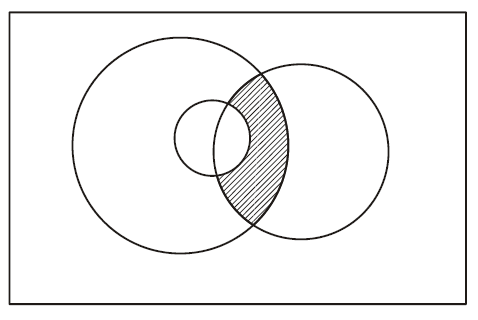
Explanation
The correct answer is A.
All students who study Spanish also study French. So the area which represents students who study Spanish must be fully contained within the area that represents the students who study French. Some students who study German also study Spanish, so the area representing the students who study Spanish must be overlapped by the area representing the students studying German. Therefore the biggest circle represents the students who study French, the medium-sized circle represents the students who study German and the smallest circle represents the students who study Spanish. Therefore the shaded area represents those who study German and French but not Spanish.
“Is cannabis really as dangerous as some people have claimed? This is an important question, since the use of cannabis has increased, and even children under 15 are known to use it. It is said that smoking cannabis is just as dangerous as smoking tobacco, in that it is equally likely to lead to death from heart disease. A number of recent studies have suggested that smoking cannabis may increase the risk of developing schizophrenia, and that those who start smoking it before age 15 have a much higher risk of becoming schizophrenic in later life. Yet since the incidence of schizophrenia in the population has remained stable whilst the use of cannabis has been increasing, it cannot be true that smoking cannabis causes schizophrenia.”
Explanation
The correct answer is E.
The passage concludes that because the incidence of schizophrenia in the population has remained stable and the use of cannabis has increased, it cannot be inferred that smoking cannabis causes schizophrenia. However, the passage specifically mentions the use of cannabis in under 15 year olds and the increased rate of schizophrenia developing in later life. Therefore, if there is little data about the use of schizophrenic people who started using cannabis under the age of 15 years, then the conclusion is weakened. This is summarised in statement E.
Statement A supports the argument.
Statement B is irrelevant to the conclusion as it discusses increased rates of schizophrenia rather than cancer.
Statement C is incorrect because it is too general to weaken the argument.
Statement D is incorrect because it is also irrelevant to the conclusion.
A certain type of window glass allows 80% of the incident light on it to pass through. 15% is reflected back and 5% is absorbed.
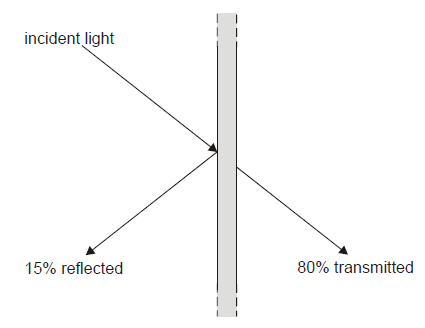
Explanation
The correct answer is B.
80% would be transmitted through the first sheet of glass, and 5% absorbed. 80% of the 80% that was transmitted through the first sheet of glass would subsequently be transmitted through the second sheet, which would be 0.80×0.80=0.64=64% of the incident light. In addition, of the 80% of the incident light transmitted through the first pane of glass 15% would be reflected off the second pane back onto the first, and then 15% of this would be reflected back onto the second pane, and then 80% of this would be transmitted through the second pane into the room. This represents 0.80×0.15×0.15×0.80=0.0144=1.44% of the incident light. Therefore in total the percentage of incident light that would be transmitted into the room is 64+1.44=65.44%.
 Humza
Medicmind Tutor
Humza
Medicmind Tutor
Thu, 03 Oct 2024 20:59:30
I don't agree with this. This could be done infinitely, although it produces a divergent series, how can we be expected to get such an answer in the allocated time?
“The UK government is committed to economic growth of 2% per year. If this goal is achieved, energy consumption in the UK will have doubled by 2050. The government is also committed to a huge reduction in carbon emissions by 2050. If energy consumption has doubled, this would require a massive increase in energy from sources other than fossil fuels, i.e. from nuclear power or from renewables such as wind, tidal and solar power. At the present rate of development of wind, tidal and solar power, these sources will be unable to meet the shortfall in supply. So although nuclear power is seen as problematic because it produces dangerous waste, it will have to continue to be used in 2050.”
1. The government’s goal for economic growth may not be achieved.
2. By 2050 we may have discovered how to store nuclear waste safely.
3. It may be possible to speed up the development of renewable energy sources.
Explanation
The correct answer is E.
Statement 1 is correct because if the rate of economic growth may not be achieved by 2050 then there will be no need for the additional energy supply and thus no need for a massive increase in energy demand from fossil fuels, nuclear energy or renewable energies.
Statement 2 is incorrect because it is irrelevant to the argument concerning the increased future demand of energy given the desired goal of increasing economic growth.
Statement 3 is correct because if renewable energy sources were developed then they could be used to meet future energy demands rather than having to rely on fossil fuels or nuclear energy to meet that increased demand to meet the increased economic growth goal.
 Humza
Medicmind Tutor
Humza
Medicmind Tutor
Thu, 03 Oct 2024 21:02:23
Don't agree with statement 1. The whole point of the paragraph is arguing to reach that goal. Saying "well what if we don't reach that goal" doesn't weaken the argument. By definition, people want to achieve their goals, so statement 1 is a critique of the governments goals more than the paragraph written
A corner shop is selling biscuits at 4 packs for the normal price of 3. At this price, the shopkeeper is making 20% profit.
Explanation
The correct answer is D.
For ease of calculation, let’s assume the normal price of a packet of biscuits is £1. So selling 4 packets for the price of 3 means each packet is being sold for ¾=0.75=75% of the original price, 1×0.75=£0.75 each. So if a profit of 20% is made at this reduced price, this would equate to 0.75×0.20=£0.15. The difference between the normal price per packet of biscuits and the reduced price is 1-0.75=£0.25. So at the normal price, an additional £0.25 profit would be made per packet of biscuits, so in total 0.15+0.25=£0.40
A farmer has an irregularly shaped buried oil tank which is 1 m in height and 2 m long. In order to estimate the volume of oil in the tank he has calculated the volume in the tank as a function of the height of oil. This height is measured by a dipstick which can be inserted through the filling hole in the top of the tank.
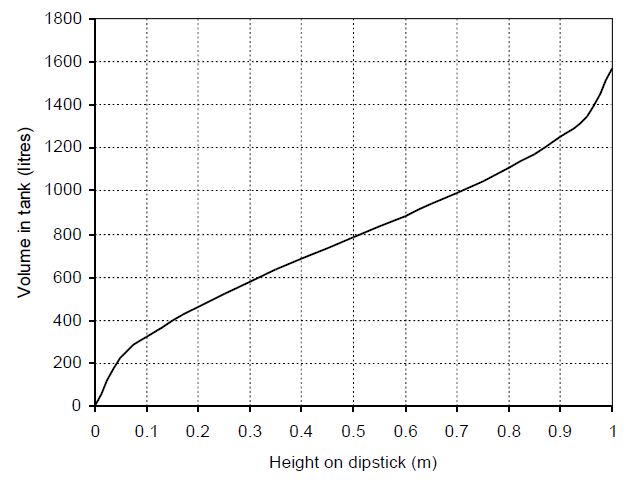
The dipstick is measuring 0.15 m so he orders 500 litres of oil. When the delivery driver has completed the fill, he measured the height again to check that the correct amount has been delivered.
Explanation
The correct answer is D.
When the dipstick read 0.15m, there would have been 400 litres in the tank according to the graph. Adding another 500 litres would mean the tank contains 400+500=900 litres of oil. According to the graph, the dipstick would read 0.6m when the tank contains 900 litres of oil.
“There is a fundamental error in the claim that wind farms will spoil Britain’s natural beauty. Most of the beautiful areas of Britain where wind farms may be sited are managed in some way, usually for agricultural reasons. Without sheep grazing, most hill and moorland areas would be forested. Without crop growing, the same would be true of most of the rest of Britain. In the 12th century, 90% of Britain was covered by woodland. Wind farms may be unsightly, but it is a mistake to refer to the natural beauty of our countryside, since ————————————–.”
Explanation
The correct answer is E.
The passage explains that wind farms are commonly used on land for agricultural purposes. It then explains how the landscape over time has changed, for example with the growing of crops. Since the text mentions the changing of landscape with an activity such as crop growing, we can assume that the landscape will change according to human activity. This is summarised in statement E.
Statement A is incorrect because there is no mention of the changing of landscapes for industrialisation purposes. The statement is too specific, as it is implying that natural beauty of the countryside cannot be accredited its beauty due to heavy industrialisation. Statement E is not as bold and specific compared to A.
Statement B is incorrect because we cannot assume that areas on which wind farms have been set up were not beautiful before their instalment.
Statement C is also incorrect because there is no mention of carbon emissions in the paragraph.
Statement D is incorrect because there is no mention of energy production and its impact on the environment.
“When a judge delivers a judgement in court, dissatisfied defendants do not stand up and shout abuse at him. They turn instead to a civilised appeals procedure. However, footballers who disagree with a referee’s decision often act like thugs and scream dissent at the referee. We should not tolerate such aggressive behaviour in a civilised society. Any player acting in this way should automatically be banned from the club’s next three games. This would be to the benefit of the school community, given that children imitate their heroes and behave similarly in the classroom and the playground.”
Explanation
The correct answer is C.
The conclusion here is that players that are aggressive should be banned from the club’s next three games. Reason is because we should not tolerate aggressive behaviour in a civilised society. However, to link these two statements we have to make the assumption that the ban will reduce aggressive behaviour.
The following is part of a Home Office study of the effects of installing CCTV (surveillance) cameras in 14 target areas with the object of reducing crime. Each target area was compared with a surrounding ‘buffer’ area, and with the entire police division.
The data shown below is for one of the target areas described as City Outskirts. The City Outskirts system comprised 47 pan, tilt and zoom (PTZ) cameras, which provided 68% coverage of the target area. This included a residential area, an arboretum (tree park), a hospital and a light industrial estate.
Fig. 1: City Outskirts – comparison of crime trends in the target, buffer and division
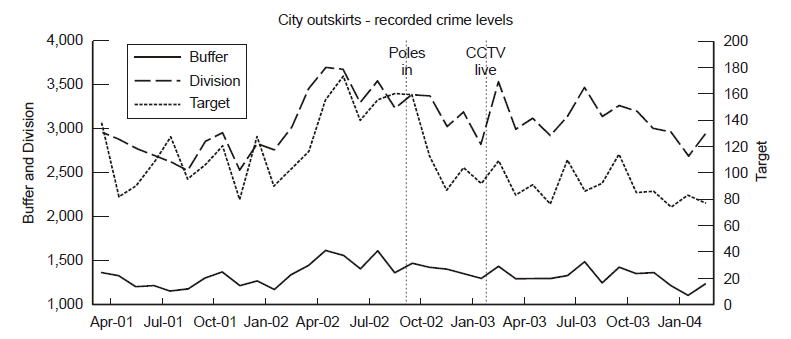
Table 1: Change in annual crime rates in the year following installation of CCTV cameras.
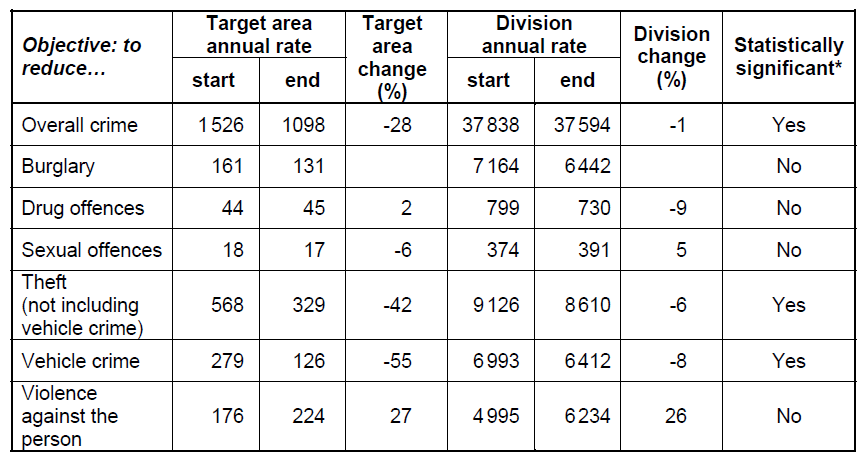
* The ‘Statistically significant’ column indicates whether the observed difference between the Target area change and the Division change is greater than we might expect by chance variations in crime rates in the absence of any real effect.
Explanation
The correct answer is B (allow 3100).
Using the figure in the row ‘Overall crime’ and the column ‘Division annual rate start’, the average monthly level of crime can be estimated as: 38000/12=3167, 3200 to the nearest 100.
The following is part of a Home Office study of the effects of installing CCTV (surveillance) cameras in 14 target areas with the object of reducing crime. Each target area was compared with a surrounding ‘buffer’ area, and with the entire police division.
The data shown below is for one of the target areas described as City Outskirts. The City Outskirts system comprised 47 pan, tilt and zoom (PTZ) cameras, which provided 68% coverage of the target area. This included a residential area, an arboretum (tree park), a hospital and a light industrial estate.
Fig. 1: City Outskirts – comparison of crime trends in the target, buffer and division

Table 1: Change in annual crime rates in the year following installation of CCTV cameras.

* The ‘Statistically significant’ column indicates whether the observed difference between the Target area change and the Division change is greater than we might expect by chance variations in crime rates in the absence of any real effect.
The study established that: ‘Following the installation of CCTV, overall crime in the target area showed a substantial fall (28%)… relative to the division as a whole (1%).’ However, it also noted there were a number of ‘confounding factors’, meaning factors which cast some doubt on the significance of the data for determining whether the change was largely attributable to CCTV.
1. The new CCTV system was supported by improvements in street and precinct lighting in November 2002.
2. There was an anti-burglary initiative in the target area during the period of the study.
3. During the peak in crime levels, changes in parking regulations reduced the number of cars parked in the target area.
Explanation
The correct answer is F.
If new CCTV was introduced at the same time at the same time as improvements in street lighting, we cannot tell to what extent the fall in crime rates was due to CCTV alone. Hence, statement 1 could be a confounding factor.
Similarly, we cannot tell if the anti-burglary initiative in the same area as the CCTV at the same time was responsible for the fall in crime rates, so statement 2 could also be a confounding factor.
Changes in parking regulations that reduced the number of cars parked in the target area could have resulted in a fall in vehicle crime at the same time the CCTV cameras were introduced, so statement 3 could also be a confounding factor.
Hence all 3 could be confounding factors.
The following is part of a Home Office study of the effects of installing CCTV (surveillance) cameras in 14 target areas with the object of reducing crime. Each target area was compared with a surrounding ‘buffer’ area, and with the entire police division.
The data shown below is for one of the target areas described as City Outskirts. The City Outskirts system comprised 47 pan, tilt and zoom (PTZ) cameras, which provided 68% coverage of the target area. This included a residential area, an arboretum (tree park), a hospital and a light industrial estate.
Fig. 1: City Outskirts – comparison of crime trends in the target, buffer and division

Table 1: Change in annual crime rates in the year following installation of CCTV cameras.

* The ‘Statistically significant’ column indicates whether the observed difference between the Target area change and the Division change is greater than we might expect by chance variations in crime rates in the absence of any real effect.
The percentage change for burglary in the Target area and in the Division are missing from the table. The difference between them was not found to be statistically significant.
Explanation
The correct answer is B.
The percentage change for burglary in the target area is (131-161)/161 x100=-18.6%.
The percentage change for burglary in the division is (6442-7164)/7164 x100=-10.1%.
Therefore the difference between theses figures is -10.1-(-18.6)=8.5%, 9% rounded.
The following is part of a Home Office study of the effects of installing CCTV (surveillance) cameras in 14 target areas with the object of reducing crime. Each target area was compared with a surrounding ‘buffer’ area, and with the entire police division.
The data shown below is for one of the target areas described as City Outskirts. The City Outskirts system comprised 47 pan, tilt and zoom (PTZ) cameras, which provided 68% coverage of the target area. This included a residential area, an arboretum (tree park), a hospital and a light industrial estate.
Fig. 1: City Outskirts – comparison of crime trends in the target, buffer and division

Table 1: Change in annual crime rates in the year following installation of CCTV cameras.

* The ‘Statistically significant’ column indicates whether the observed difference between the Target area change and the Division change is greater than we might expect by chance variations in crime rates in the absence of any real effect.
The category of crime showing the biggest change in the Target area was vehicle crime. This may have been a freak result.
Explanation
The correct answer is B.
Excluding the figures given for vehicle crime, the target area annual rate at the start would be 1526-279=1247, and the target area annual rate at the end would be 1098-126=972. So the target area percentage change excluding vehicle crime would be (972-1247)/1247 x100=22%.
The following is part of a Home Office study of the effects of installing CCTV (surveillance) cameras in 14 target areas with the object of reducing crime. Each target area was compared with a surrounding ‘buffer’ area, and with the entire police division.
The data shown below is for one of the target areas described as City Outskirts. The City Outskirts system comprised 47 pan, tilt and zoom (PTZ) cameras, which provided 68% coverage of the target area. This included a residential area, an arboretum (tree park), a hospital and a light industrial estate.
Fig. 1: City Outskirts – comparison of crime trends in the target, buffer and division

Table 1: Change in annual crime rates in the year following installation of CCTV cameras.

* The ‘Statistically significant’ column indicates whether the observed difference between the Target area change and the Division change is greater than we might expect by chance variations in crime rates in the absence of any real effect.
1. It might indicate whether criminal activity is displaced to areas adjacent to the target area.
2. It explains why figures for the target area are not reflected by the division as a whole.
3. It gives some indication of whether falling crime in the target area is part of a more general trend in one sector of the division.
Explanation
The correct answer is E.
If data from the buffer area shows that criminal activity is similar here to in the adjacent target area, it would indicate that these crime levels are not just confined to the target area and may suggest a more general trend. Therefore statements 1 and 3 are correct.
The data from the buffer area may alternatively show that figures for the target area are not reflected by the division as a whole (if the crime rates in the buffer area are significantly different to in the target area). But data alone could not offer a reason for this difference, so statement 2 does not explain why data from the buffer area is important.
In the ideal examination, in order to maximise the discrimination between candidates, there should be a range of questions such that: the more difficult questions are answered correctly by only a small number of the best candidates and the easier questions are answered correctly by all but a small number of the weaker candidates.
The graph below shows the distribution of results for a given examination.
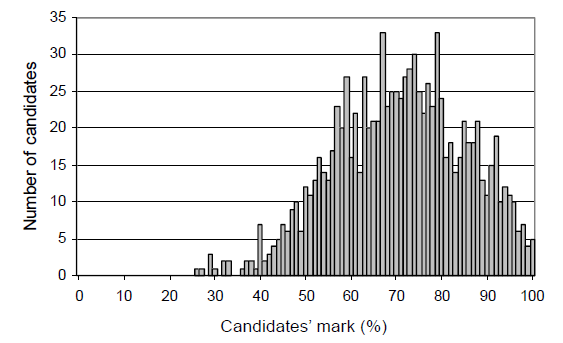
Explanation
The correct answer is A & C.
The distribution is skewed to the right, which means students on average got a higher mark than in an ideal examination. As the entire normal distribution has been shifted right, it must mean that the easy questions were answered correctly by too many and the harder questions were also answered correctly by too many. Therefore A and C are correct.
A maze is drawn as shown below with the lines representing ‘hedges’.
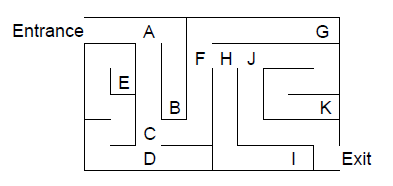
If, however, a plan is drawn showing the paths through the maze, along with the decision points and dead ends, as shown below, the best route through the maze (on paper at least) becomes more obvious.

A second maze is shown below. The objective in this maze is to reach point X.
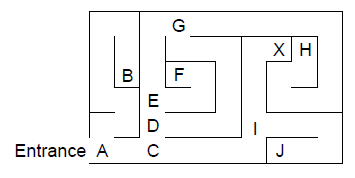
The path plan of this maze is shown below but it has one line missing.
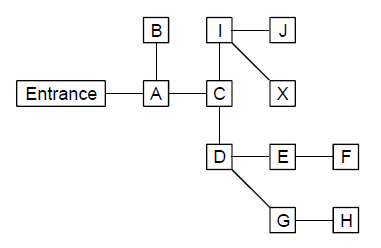
Explanation
The correct answer is C.
Going through each of the letters in turn, in the maze:
A is connected to B and C
B is only connected to A
C is connected to D and I
D is connected to C, E and G
E is connected to D, F and G
But there is no line connecting G and E on the path plan of the maze. So C is the answer.
“So far the only foolproof way of identifying a dinosaur’s sex has been to find unlaid eggs inside the body, and only two such fossils are known. Now a structure called medullary bone, which is otherwise found only in the bones of female birds, has been identified inside the femur of a 69 million-year-old T-Rex fossil. In birds the medullary bone is densely mineralised and rich in blood vessels. It acts as a store of calcium and without it, the calcium needed to form eggshells would have to come from the birds’ normal bones, leaving them vulnerable to osteoporosis. As their eggs form, the shell formation depletes the medullary bone, which remains undetectable during brooding and until the next ovulation.”
Explanation
The correct answer is A.
Medullary bones are only found in female dinosaurs. So we can say that if a fossil has a medullary bone, it must be female. A male dinosaur fossil will not have a medullary bone. However the converse may not be true: if we have a fossil that does not have a medullary bone, it could be male or female – some female dinosaurs may have lacked a medullary bone. Therefore for a dinosaur fossil to be male, it must not have a medullary bone, but the absence of this bone is not enough to confirm that the fossil is male. Therefore the absence of a medullary bone is a necessary but not a sufficient condition when trying to determine that a dinosaur fossil is male.
The pie charts below show the results of a survey of the inhabitants of a village. The chart on the left shows the age distribution. The chart on the right shows the methods normally used to travel from home to their school, place of work etc. (In the case of the very young the mode of transport is that used by their parents to take them to nursery group etc.)
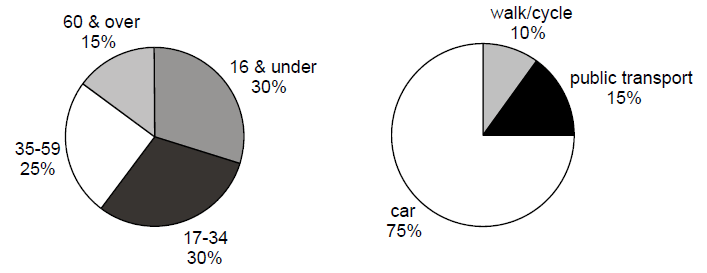
1. At least 1/6 of the 17-34 age group travel by car.
2. No more than half of the 16 & under age group travel by public transport.
3. Some of those under 60 travel by walking or cycling.
Explanation
The correct answer is B.
If all of the people who walked or cycled or used public transport were aged 17-34, minimising the percentage that use car in this age group, there would still be 30-(10+15)=5% of within this age group of all the inhabitants that travelled by car. Out of the age category 17-34, this represents 5/30=⅙. Therefore statement 1 is correct.
Half of the 16 and under group would be 30/2=15% of all of the inhabitants, which is the same percentage of inhabitants which travel by public transport, therefore no more than half of under 16s could be using public transport and statement 2 can be concluded from the data.
As the over 60 age category only includes 15% of all inhabitants and 75% of all inhabitants travel by car, we cannot determine whether all inhabitants over 60 travel by car or use public transport, or if some walk/cycle. Therefore statement 3 cannot be concluded.
Hence, only statements 1 and 2 can be concluded.
I have an electronic device which, on the press of a button, generates a number between 1 and 6. It is supposed to generate numbers randomly, but I have noticed that it generates numbers in groups of four that always add up to 14, and it never generates more than five consecutive odd numbers or even numbers.
In the game I am currently playing using this device, the last fifteen numbers (in order from earliest to latest) have been:
…..344241562425355
Explanation
The correct answer is B.
The first 4 numbers listed add up to 3+4+4+2=13, so try adding up the 4 numbers one number along the list: 4+4+2+4=14, therefore we can separate the following numbers into groups of four numbers that add up to 14 from here onwards. The following sets would be 1+5+6+2, and then 4+2+5+3, leaving 5+5 to start the next set of four numbers. We know that 5 consecutive odd numbers cannot be generated, and we have already had 4 generated (5,3,5,5), so the next number must be even. We also know that the two numbers in the list after 5,5 must add up to 14-(5+5)=4. The only possible combination of number in which the first is even which add up to 4 is 2 and 2, so the next number must be 2.
“Despite alarming warnings about the possibility of a global epidemic of bird flu, there is no chance that bird flu will kill thousands of people in Britain. References to the 1918-1919 flu epidemic, when millions died, are misleading. In those days the economy of the country was weak, so the population was vulnerable to infections due to poor nutrition. Now we have a strong economy, therefore children can develop a strong immune system through good nutrition. We are told that increases in the amount of global travel makes it more likely that deadly diseases will spread around the world. Frequent global travellers become immune to infectious diseases simply because they have been exposed to so many of them. So global travel helps to immunise the population.”
1. The vast majority of residents of Britain are not frequent global travellers.
2. Being immune to a number of infectious diseases may not confer immunity to all infectious diseases.
3. The strength of the economy is not the only influence on the quality of children’s nutrition.
Explanation
The correct answer is F.
Given that the final conclusion is that ‘global travel helps to immunise the population’ all statements would make the conclusion unsafe.
Statement 1 is correct because if the vast majority of British residents do not travel frequently, then they will not be immunised to ‘all infectious diseases’.
Statement 2 is would weaken the conclusion because being immune to one disease does not necessarily equate to immunity against other infectious diseases.
Statement 3 is correct as children’s nutrition can be influenced by a number of things, not only the strength of the economy.
I am trying to buy a particular type of car second hand. These cars are in great demand and I know that if I am not quick, they will be bought by other people.
I have bought tonight’s paper as early as possible. Four such cars are advertised and I have arranged to see the owners. I know that I must make an instant decision on each as otherwise they will sell before I can return.
If I buy the first one I see, there is only a 1 in 4 chance of it being the best. Similarly, if I wait until the last one, there is only a 1 in 4 chance of it being the best. I therefore decide on the following strategy: I will look at the first one and not buy it. I will then buy the first one I see which is better than the first one. If the other two are worse than the first one, I will buy the fourth.
Explanation
The correct answer is D.
 SS
Medicmind Tutor
SS
Medicmind Tutor
Fri, 29 Oct 2021 14:56:45
What is the explanation for this answer?
 D
Medicmind Tutor
D
Medicmind Tutor
Tue, 15 Feb 2022 12:03:54
So consider the following situation: If A is the best, then P of getting correct is 0 If B is the best, then P of getting correct is 1 If C is the best, then P of getting correct is 1/2 [because he could have chosen B] If D is the best, then P of getting correct is 1/3 (again he could have chosen B and C] you add all together and divide by 4, hence D
“Patients who have had a heart-attack or by-pass operation are advised to take a ‘mini’ aspirin (75mg) a day to reduce the risk of further trouble. Aspirin, it is thought, reduces the body’s production of prostaglandins, which can cause platelets in the blood to clump together, increasing the risk of clots. So should we all be taking it, given that aspirin can induce internal bleeding, and carries a slight risk of cerebral haemorrhage?
Typically doctors advise aspirin only if a patient is found to have a 3% or higher chance of a first heart attack or stroke within five years. Research showed 80% of men pass this threshold by age 50 – on average it is reached by the age of 40. Among the risks which start to add up to a first heart attack are family history, being overweight, smoking, lack of exercise, high blood fat levels and high blood pressure.”
1. Whether or not to take aspirin is a matter of balancing risks and benefits.
2. Anyone over 50, in a sedentary occupation, should certainly take aspirin each day.
3. Risk of heart attack in men increases by 30% between the ages of 40 and 50.
Explanation
The correct answer is A.
Statement 1 is the only statement that can be safely concluded from the paragraph because it generally discusses the benefits and risks of taking a ‘mini’ dose of aspirin by outweighing the risks of developing a clot if not taken versus the risk of having a cerebral haemorrhage if taken.
Statement 2 is not correct as the word ‘certainly’ implies that given those risk factors, aspirin must be taken, which is not supported in the paragraph.
Statement 3 is incorrect because there is no information regarding increase in heart attack percentage between ages 40-50 years of age.
“Patients who have had a heart-attack or by-pass operation are advised to take a ‘mini’ aspirin (75mg) a day to reduce the risk of further trouble. Aspirin, it is thought, reduces the body’s production of prostaglandins, which can cause platelets in the blood to clump together, increasing the risk of clots. So should we all be taking it, given that aspirin can induce internal bleeding, and carries a slight risk of cerebral haemorrhage?
Typically doctors advise aspirin only if a patient is found to have a 3% or higher chance of a first heart attack or stroke within five years. Research showed 80% of men pass this threshold by age 50 – on average it is reached by the age of 40. Among the risks which start to add up to a first heart attack are family history, being overweight, smoking, lack of exercise, high blood fat levels and high blood pressure.”
Which of the following could be safely concluded from the passage?
1. Whether or not to take aspirin is a matter of balancing risks and benefits.
2. Anyone over 50, in a sedentary occupation, should certainly take aspirin each day.
3. Risk of heart attack in men increases by 30% between the ages of 40 and 50.
Explanation
The correct answer is D.
(2x5x5x5)+(3×5)+1=266.
 Khyama Abid
Medicmind Tutor
Khyama Abid
Medicmind Tutor
Sat, 08 Oct 2022 12:37:49
The question is not stated
Can Mainstream Medicine and Alternative Therapies Coexist?
There is something brewing in the world of medicine and it’s a lot stronger than a cup of chamomile tea. It is a shift of thinking on the whole question of alternative medicine, not just by patients, but by many doctors as well. Not so long ago most U.S. physicians scoffed at the very idea that anything outside their strictly Western-based style of medicine could help their patients. Average consumers, too, were reluctant to experiment with forms of treatment that – in their own minds at least – were shrouded in mystery, or smacked of sorcery and hocus-pocus.
But by 1990 a landmark study by Harvard Medical School found that an astonishing one-in-three Americans (out of a population of 247 million) had visited an alternative therapist in the previous year. Shortly afterwards the National Institute of Health reported that in that same year 425 million visits by US citizens were made to alternative health practitioners, compared to 388 million visits to conventional primary care physicians. Consumers made more visits to chiropractors, acupuncturists, homeopaths, herbalists, and other alternative healers than to all primary care physicians combined.
So what has happened? Probably the most significant contribution to the popularity of non-traditional therapies has been the gnawing dissatisfaction of patients with a health care system that has become increasingly depersonalized and remote. They complain that all too often, after taking expensive pharmacological treatments, they have simply traded symptoms for side-effects. Even the best doctors are frustrated that combining the art of healing with the science of medicine is getting harder and harder to do. They point out that the time it takes to get to know their patients, to listen, counsel and reassure, is – unfortunately – at a premium. For many, this is the void that alternative medicine appears to be filling.
Increasingly there appears to be a grudging truce between the camps, although allegations are still flying. Medical doctors accuse alternative practitioners of selling unscientific and ineffective therapies, and the alternative camp hurls charges that too many physicians are insensitive and quick to promote invasive procedures as cures. One obstacle to better understanding is the lack of agreement on a central definition of ‘alternative’ therapies. Some define them as those that are not widely practiced in hospitals or taught in U.S. medical schools. The cornerstone of alternative medicine appears to be the unwavering belief in the body’s ability to heal itself. Another focus is on “holism,” or the tenet that all aspects of a person – body, mind and spirit – are somehow interrelated and should be treated as a whole. The success of alternative techniques is often judged by the overall well-being of the patient, and does not just concentrate on the disease itself.
Explanation
The correct answer is B.
‘One-in-three Americans (out of a population of 247 million) had visited an alternative therapist in the previous year. Shortly afterwards the National Institute of Health reported that in that same year 425 million visits by US citizens were made to alternative health practitioners.’
425/(247/3)~425/(240/3)~400/80=5.
Can Mainstream Medicine and Alternative Therapies Coexist?
There is something brewing in the world of medicine and it’s a lot stronger than a cup of chamomile tea. It is a shift of thinking on the whole question of alternative medicine, not just by patients, but by many doctors as well. Not so long ago most U.S. physicians scoffed at the very idea that anything outside their strictly Western-based style of medicine could help their patients. Average consumers, too, were reluctant to experiment with forms of treatment that – in their own minds at least – were shrouded in mystery, or smacked of sorcery and hocus-pocus.
But by 1990 a landmark study by Harvard Medical School found that an astonishing one-in-three Americans (out of a population of 247 million) had visited an alternative therapist in the previous year. Shortly afterwards the National Institute of Health reported that in that same year 425 million visits by US citizens were made to alternative health practitioners, compared to 388 million visits to conventional primary care physicians. Consumers made more visits to chiropractors, acupuncturists, homeopaths, herbalists, and other alternative healers than to all primary care physicians combined.
So what has happened? Probably the most significant contribution to the popularity of non-traditional therapies has been the gnawing dissatisfaction of patients with a health care system that has become increasingly depersonalized and remote. They complain that all too often, after taking expensive pharmacological treatments, they have simply traded symptoms for side-effects. Even the best doctors are frustrated that combining the art of healing with the science of medicine is getting harder and harder to do. They point out that the time it takes to get to know their patients, to listen, counsel and reassure, is – unfortunately – at a premium. For many, this is the void that alternative medicine appears to be filling.
Increasingly there appears to be a grudging truce between the camps, although allegations are still flying. Medical doctors accuse alternative practitioners of selling unscientific and ineffective therapies, and the alternative camp hurls charges that too many physicians are insensitive and quick to promote invasive procedures as cures. One obstacle to better understanding is the lack of agreement on a central definition of ‘alternative’ therapies. Some define them as those that are not widely practiced in hospitals or taught in U.S. medical schools. The cornerstone of alternative medicine appears to be the unwavering belief in the body’s ability to heal itself. Another focus is on “holism,” or the tenet that all aspects of a person – body, mind and spirit – are somehow interrelated and should be treated as a whole. The success of alternative techniques is often judged by the overall well-being of the patient, and does not just concentrate on the disease itself.
Explanation
The correct answer is C.
C can be inferred, as supported by the following in paragraphs 3 and 4:
‘Probably the most significant contribution to the popularity of nontraditional therapies has been the gnawing dissatisfaction of patients with a health care system that has become increasingly depersonalized and remote.’
‘They point out that the time it takes to get to know their patients, to listen, counsel and reassure, is – unfortunately – at a premium. For many, this is the void that alternative medicine appears to be filling.’
‘too many physicians are insensitive and quick to promote invasive procedures as cures.’
Can Mainstream Medicine and Alternative Therapies Coexist?
There is something brewing in the world of medicine and it’s a lot stronger than a cup of chamomile tea. It is a shift of thinking on the whole question of alternative medicine, not just by patients, but by many doctors as well. Not so long ago most U.S. physicians scoffed at the very idea that anything outside their strictly Western-based style of medicine could help their patients. Average consumers, too, were reluctant to experiment with forms of treatment that – in their own minds at least – were shrouded in mystery, or smacked of sorcery and hocus-pocus.
But by 1990 a landmark study by Harvard Medical School found that an astonishing one-in-three Americans (out of a population of 247 million) had visited an alternative therapist in the previous year. Shortly afterwards the National Institute of Health reported that in that same year 425 million visits by US citizens were made to alternative health practitioners, compared to 388 million visits to conventional primary care physicians. Consumers made more visits to chiropractors, acupuncturists, homeopaths, herbalists, and other alternative healers than to all primary care physicians combined.
So what has happened? Probably the most significant contribution to the popularity of non-traditional therapies has been the gnawing dissatisfaction of patients with a health care system that has become increasingly depersonalized and remote. They complain that all too often, after taking expensive pharmacological treatments, they have simply traded symptoms for side-effects. Even the best doctors are frustrated that combining the art of healing with the science of medicine is getting harder and harder to do. They point out that the time it takes to get to know their patients, to listen, counsel and reassure, is – unfortunately – at a premium. For many, this is the void that alternative medicine appears to be filling.
Increasingly there appears to be a grudging truce between the camps, although allegations are still flying. Medical doctors accuse alternative practitioners of selling unscientific and ineffective therapies, and the alternative camp hurls charges that too many physicians are insensitive and quick to promote invasive procedures as cures. One obstacle to better understanding is the lack of agreement on a central definition of ‘alternative’ therapies. Some define them as those that are not widely practiced in hospitals or taught in U.S. medical schools. The cornerstone of alternative medicine appears to be the unwavering belief in the body’s ability to heal itself. Another focus is on “holism,” or the tenet that all aspects of a person – body, mind and spirit – are somehow interrelated and should be treated as a whole. The success of alternative techniques is often judged by the overall well-being of the patient, and does not just concentrate on the disease itself.
Explanation
The correct answer is D.
BMAT 2005 S1 Review Screen
Instructions
Below is a summary of your answers. You can review your questions in three (3) different ways.
The buttons in the lower right-hand corner correspond to these choices:
1. Review all of your questions and answers.
2. Review questions that are incomplete.
3. Review questions that are flagged for review. (Click the 'flag' icon to change the flag for review status.)
You may also click on a question number to link directly to its location in the exam.
BMAT 2005 S1 Section
Final Answer Review Screen
Instructions
This review section allows you to view the answers you made and see whether they were correct or not. Each question accessed from this screen has an 'Explain Answer' button in the top left hand side. By clicking on this you will obtain an explanation as to the correct answer.
At the bottom of this screen you can choose to 'Review All' answers, 'Review Incorrect' answers or 'Review Flagged' answers. Alternatively you can go to specific questions by opening up any of the sub-tests below.
BMAT 2005 S1 Section
TI-108